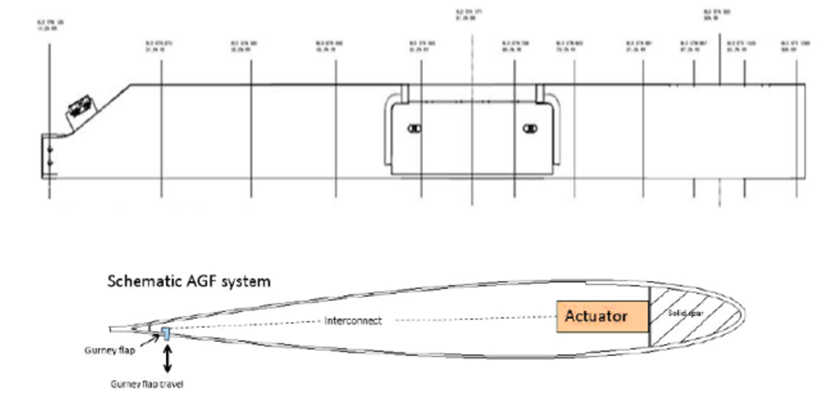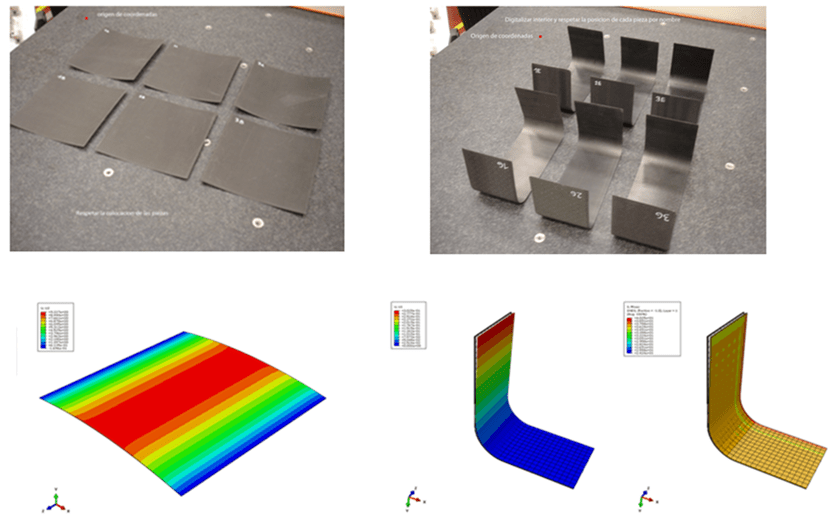One of the most challenging areas of research leaded by the Green Rotorcraft Consortium (GRC) within the Clean Sky Program was the development of Active Rotor Technologies as the Active Gurney Flap (AGF) systems, which enable a helicopter to operate with a reduced tip speed of its main rotor whilst preserving the current flight capabilities. The on-going validation of innovative AGF systems by the GRC required the manufacturing and testing in wind tunnel tests of small scale composite model blades before their implementation at full scale. The integration of the AGF systems into the model blades (figure 1) demanded a precise process and tooling design in order to allow an accurate assembly for an efficient performance.
Figure 1 Scheme of rotorcraft model blade with AFG system
Due to the small scale, the dimensional tolerances of the model rotor blade were very tight (less than +/- 0,1mm on the aerodynamic profile). This fact represented a great challenge for process and tooling design. Actually, to fulfil those tight tolerances, not only the mould had to be machined with very high precision means, but also the cavity design had to be designed with special consideration for minimizing any shape distortion induced by the process due to the different thermal and chemical shrinkage of the materials.
In close collaboration with the GRC consortium, CIDAUT contributed with its expertise in composite materials processing, and an innovative tooling design methodology. This methodology was based in process simulations capable of predicting distortions and solving process related issues from the early design stage. The methodology also avoided the need for expensive and long lasting trial and error procedures. Process simulation models developed by CIDAUT in the ACCUBLADE project included thermal and impregnation simulations for the analysis and optimization of critical process related issues, such as shape distortions caused by the different CTE of the materials, temperature gradients, or potential resin flow defects.
Laboratory characterisation tests were carried out with the selected materials in order to determine the required input data for the modelling of the most relevant causes of distortions when processing composite materials, including the warping and spring-in phenomena. Process simulation models were well correlated with experimental results obtained through the processing of flat and C-profile coupons with different layups and curing conditions (figure 2).
Figure 2 Simulation of process induced distortions: warping and spring-in phenomena
Based on the results of process simulations, the design of the suite of tools required for the processing of the model blades was optimized. This included the selection of the optimum tool materials, the definition of the proper alignment and clamping systems, and the integration of an efficient and homogenous heating and cooling system with in-mould sensors. Also, with the aim of evaluating potential improvements in the manufacturing process in terms of quality and costs, the mould was designed and manufactured allowing the evaluation of two alternative processes, both aimed at producing the same net model rotor blade product: compression moulding and SQRTM.
All tools were manufactured by CIDAUT using very fine milling means, and inspected to guarantee the fulfilment of the requirement specifications before putting them at the disposal of the GRC consortium for the processing of the model blades. The first three model blades produced with the tools (figure 3) were used for the validation of process and tooling designs, being subjected to destructive and non-destructive inspection tests including mechanical substantiation tests with fully satisfactory results.
Figure 3 Rotorcraft model blade produced for the integration of AGF systems


